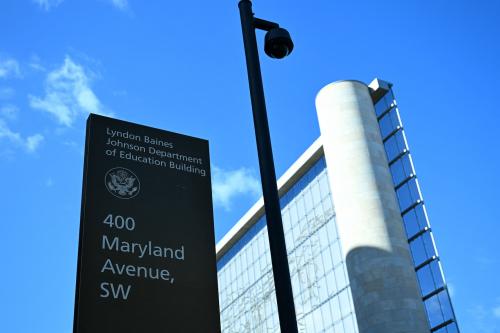Editor’s Note: As part of the 2014 Midterm Elections Series, we’ve asked experts from the ten states with competitive Senate races to answer six questions in a spotlight on each race, providing perspective on the dynamics in the state as we head toward Election Day. In this post, Jason Husser looks at key issues in the North Carolina Senate race between Senator Kay Hagan and Thom Tillis.
1. What have been the three key issues in this year’s Senate race?
Just as the legislative productivity of the Republican North Carolina General Assembly under Speaker Thom Tillis has been remarkable, it has also been extremely controversial. Similarly, President Obama’s legislative accomplishments, particularly the Affordable Care Act, have been divisive in the Old North State.
Rather than several specific policy issues, the North Carolina U.S. Senate race has been largely defined for voters as “a pick your less-than-beloved side.” Campaigns have asked voters to think of issues as policy package from either Barack Obama or the Republicans in Raleigh. All said, this race is unusual among midterms because it has turned into a reflection not just on the President and national agenda, but also on a collection of state policies like education funding outside of a U.S. Senator’s typical purview.
2. How have the candidates handled these issues and which candidate has been the strongest on those issues?
For a Senate race that might top $100 million in spending, much of the content of messaging has been consistent with national advertisement regularities. In my opinion, neither campaign has produced masterful communications. However, given the weak support for national Democrats in North Carolina, Tillis started this race in a good position to gain the upper hand and failed to capitalize fully on it. Hagan, in contrast, has succeeded by focusing the issues on those that benefit Tillis the least.
3. Have any other issues resonated specifically with key demographic groups or interests and what are the implications for the race?
The biggest demographic factor in the North Carolina U.S. Senate race is the gender gap. My last Elon University Poll showed Hagan with a 19-point advantage among likely female voters and Tillis with a 12-point advantage among male voters. Among single women, Hagan commanded an incredible lead of 65 to 18. Likely recognizing her advantage among women voters, Hagan has been successful at turning every conversation into one that will help maintain her lead among female voters.
4. How have outside surrogates, SuperPACs, or other outside spending played a role in the race?
Regarding surrogates, both Tillis and Hagan have few allies who would reliably and widely rally their bases and not alienate moderates. However, both candidates have seen some useful support. Hillary Clinton and Barbara Mikulski have made appearances for Hagan. NASCAR Legend Richard Petty and Paul Ryan have stumped for Tillis.
The major weakness of both candidates in terms of surrogates is the lack of cachet executive-branch affiliates have among North Carolina voters. The Elon Poll conducted a series of online survey-based experiments to test President Obama and Governor McCrory’s influence of each candidate. In the Obama experiment, we asked a control group to evaluate Senator Hagan after viewing a picture of Hagan by herself. The treatment group viewed a picture of Hagan with the President. Similarly, a separate McCrory experiment compared evaluations of Tillis in a control group that saw just Tillis to a treatment group that saw Tillis with his co-partisan Governor. Obama’s image hurt Hagan in almost every subpopulation, even among Democrats. McCrory’s image also hurt Tillis, though to a lesser extent than the Obama effect.
5. Midterms are often characterized by low turnout. What are your expectations about voter apathy/engagement in this race?
The standard for a high turnout midterm election in North Carolina is the 1990 U.S. Senate race between very conservative Jesse Helms and African-American Charlotte mayor Harvey Gantt. In 1990, turnout was 62 percent. In contrast, turnout was 44 percent in the most recent North Carolina midterm election. I expect turnout to be atypically high in 2014 given the competitiveness of the race and the massive amount of money spent.
6. National media attention to this Senate race has been substantial. What important aspects have the media overlooked that may surprise outside observers on Election Day?
Three factors shaping the North Carolina Senate race are worth noting.
First, emigration from the BosWash corridor maintains North Carolina as a state in flux between its reliably conservative Southern roots and its more liberal Mid-Atlantic neighbors.
Second, Thom Tillis’ decision to remain Speaker of the House seems to have hurt him for two reasons. It distracted him from campaigning. It eased the task of painting him with the unpopularity of state Republican policies, somewhat ironically as Tillis actually helped temper some of the output of the state legislature.
Third, Moral Monday, the left-leaning protest movement, appears to have had lingering indirect effects in favor of Hagan by raising the salience of Tillis’s legislative record and while softening his resistance to criticisms.
The Brookings Institution is committed to quality, independence, and impact.
We are supported by a diverse array of funders. In line with our values and policies, each Brookings publication represents the sole views of its author(s).




Commentary
2014 Midterms: Key Issues in the North Carolina Senate Race
October 24, 2014